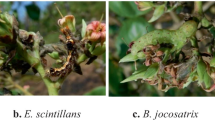Abstract
The occurrence of flower chafer beetle, Oxycetonia versicolor (Fabricius) (Scarabaeidae: Coleoptera) damaging the flowers of important grain legumes such as pigeonpea (Cajanus cajan (L.) Millsp.) and mungbean (Vigna radiata (L.) Wilczek) is reported for the first time from Punjab, India. Heavy infestation of these flower beetles at flowering may cause considerable damage to these crops. A mild to moderate level of infestation of 15–17 beetles per ten plants was recorded at the time of peak flowering period on both the grain legumes. Adult beetles devour the flowers and buds, thereby greatly reducing the number of pods that are set. Information on important taxonomic characters of the beetle is highlighted in this report. Careful monitoring and timely reporting on this chafer beetle is necessary to avoid any future outbreak.


Similar content being viewed by others
References
Ambethgar, V. (2000). Report of cetonid beetle Oxycetonia versicolor Fab. on brinjal from Tamil Nadu, India. Insect Environment, 5, 170.
Arrow, G. J. (1910). The fauna of British India including Ceylon and Burma, Col. Lamell. I (Cetoniinae and Dynastinae). London, UK: Taylor and Francis.
Deshpande, S. V., & Rao, S. N. (1980). Population fluctuations of the cetoniid beetle (Oxycetonia versicolor). Research Bulletin of Marathwada Agricultural University, 4, 90–91.
Dhaliwal, G. S., & Arora, R. (2006). Integrated pest management: concepts and approaches. New Delhi, India: Kalyani Publishers.
Dhaliwal, G. S., & Koul, O. (2010). Quest for pest management: From green revolution to gene revolution. New Delhi, India: Kalyani Publishers.
Duraimurugan, P., & Srinivasan, T. (2009). Insects and mite assuming status of pests in mungbean. Pulses Newsletter, 20, 3. IIPR, Kanpur, India.
Fairmaire, L. (1893). Bulletin de la Société Entomologique de France, 322–325.
Fletcher, T. B. (1917). Report of the proceedings of the second entomological meeting. Vol. 2. Calcutta, India: Superintendent Government Printing.
Hinckley, A. D. (1967). Associates of the coconut rhinoceros beetle in Western Sama. Pacific Insects, 9, 505–511.
Kolbe, H. J. (1910). Mitteilungen aus dem Zoologischen Museum Berlin, 5, 1–49.
Kumar, A. (2005). Changing scenario of insect pest problems. In H. C. L. Gupta, A. Kumar, O. P. Ameta, & S. Jain (Eds.), Alternatives to chemical pesticides in pest management (pp. 21–38). Udaipur, India: Agrotech Publishing Academy.
Kumar, S., Sankar, M., Sethuraman, V., & Musthak, A. (2009). Population dynamics of white grubs (Coleoptera: Scarabaeidae) in the rose environment of Northern Bangalore, India. Indian Journal of Science and Technology, 2, 46–52.
Matot, P. (2000). Note on the flower scarab Oxycetonia versicolor (Fabricius, 1775) (Coleoptera: Scarabaeidae) in the Seychelles. Phelsuma, 8, 77–78.
Nwanze, K. F., & Youm, O. (Eds.) (1995). Panicle insect pests of sorghum and pearl millet: Proceedings of an International Consultative Workshop (1993, ICRISAT Sahelian Center, Niamey, Niger). [English summaries; Andhra Pradesh, India: International Crops Research Institute for the Semi-Arid Tropics.]
Reed, W., Lateef, S. S., Sithanantham, S., & Pawar, C. S. (1989). Pigeonpea and chickpea insect identification handbook. Information Bulletin 26. Patancheru, India: ICRISAT.
Shanker, C., & Dhyani, S. K. (2006). Insect pests of Jatropha curcas L. and the potential for their management. Current Science, 91, 162–163.
Tremblay, E. (2000). Entomologia applicata. Vol. IV, part 1. Napoli, Italy: Liguori Editore.
Veeresh, G. K., & Rajanna, C. (1981). Seasonal activity of Scarabaeids as evidenced by light trap catches. Progress in Soil Biology and Ecology. UAS Technical Series, 37, 153–158.
Viggiani, G. (1926). Alcune notizie sulla morfologia e sulla biologia della Tropinota hirta, con speciale rigurado ai danni da essa recati alle coltivazioni erbacee ed arboree. Bollettino della Società dei Naturalisti in Napoli, 37, 28–53.
Acknowledgments
The authors are extremely thankful to the Head, Department of Plant Breeding & Genetics, Incharge (Pulses Section), as well as to the Head, Department of Entomology, P.A.U., Ludhiana, for providing the research facilities required to accomplish this study.
Author information
Authors and Affiliations
Corresponding author
Rights and permissions
About this article
Cite this article
Taggar, G.K., Singh, R., Kumar, R. et al. First report of flower chafer beetle, Oxycetonia versicolor, on pigeonpea and mungbean from Punjab, India. Phytoparasitica 40, 207–211 (2012). https://doi.org/10.1007/s12600-012-0222-8
Received:
Accepted:
Published:
Issue Date:
DOI: https://doi.org/10.1007/s12600-012-0222-8




